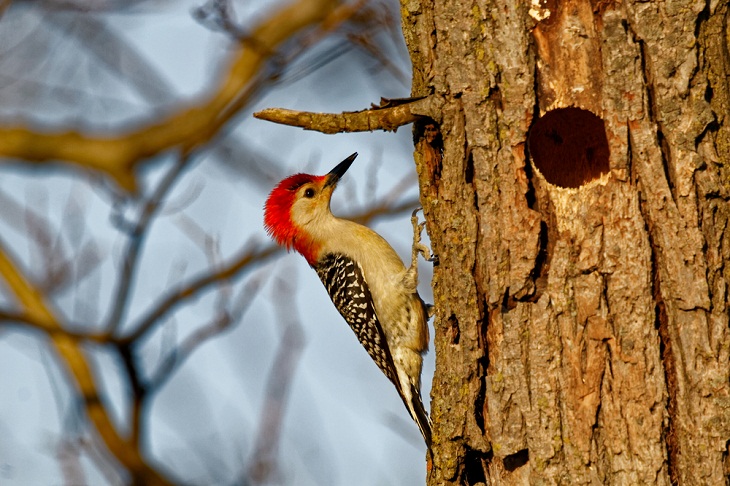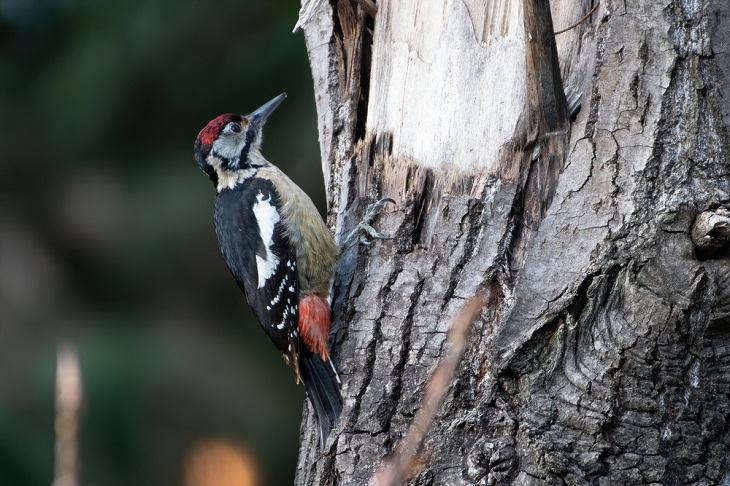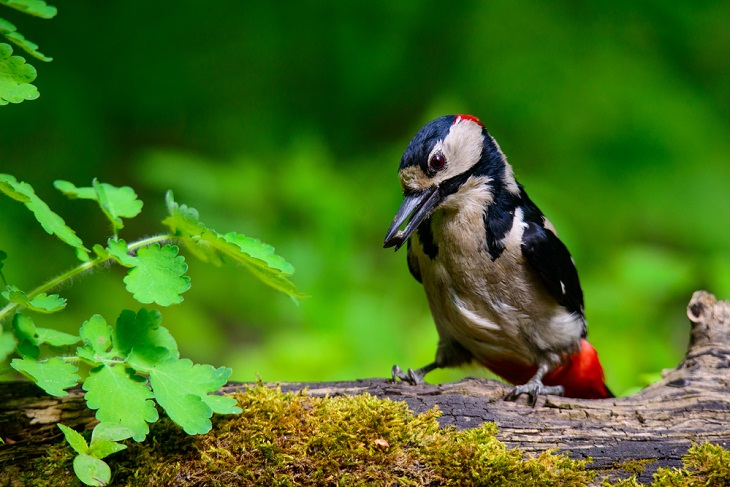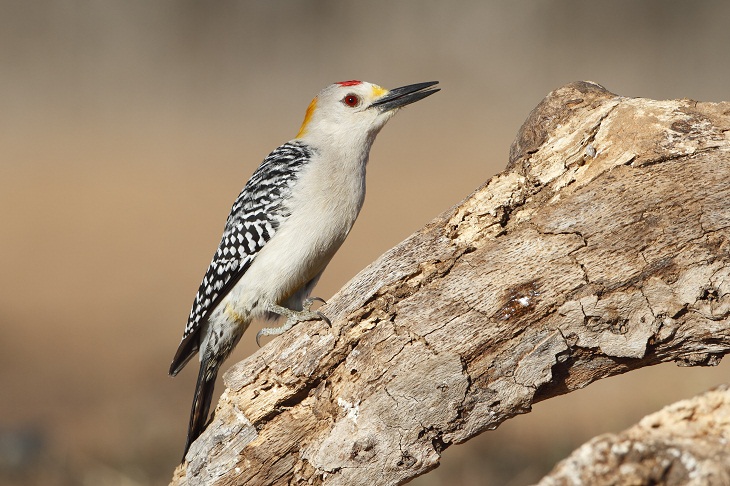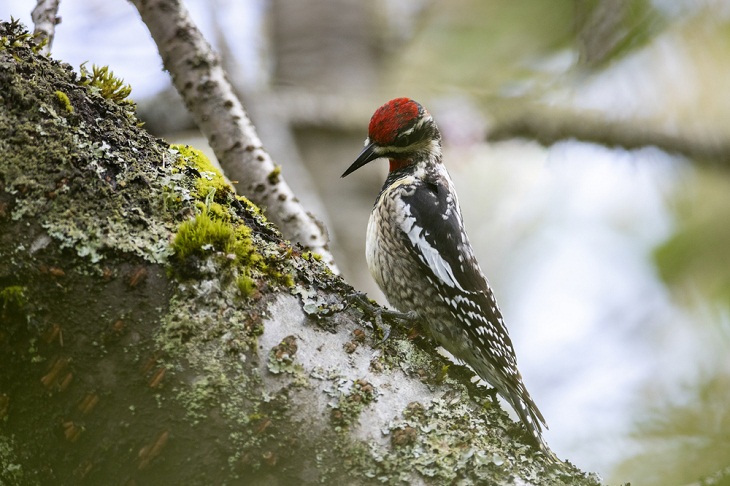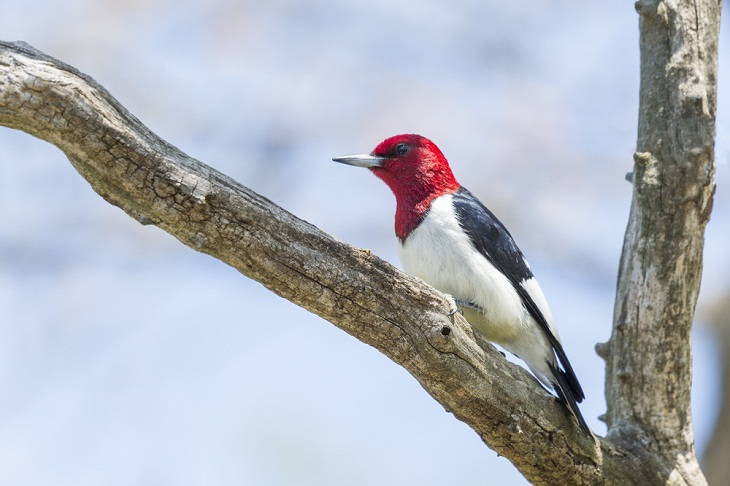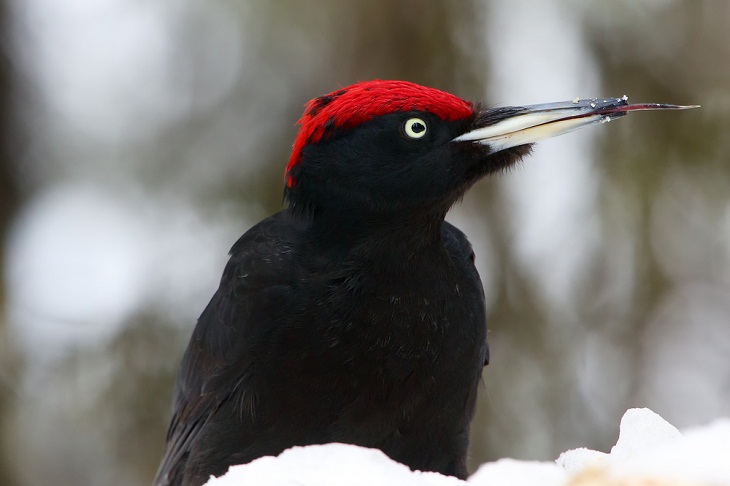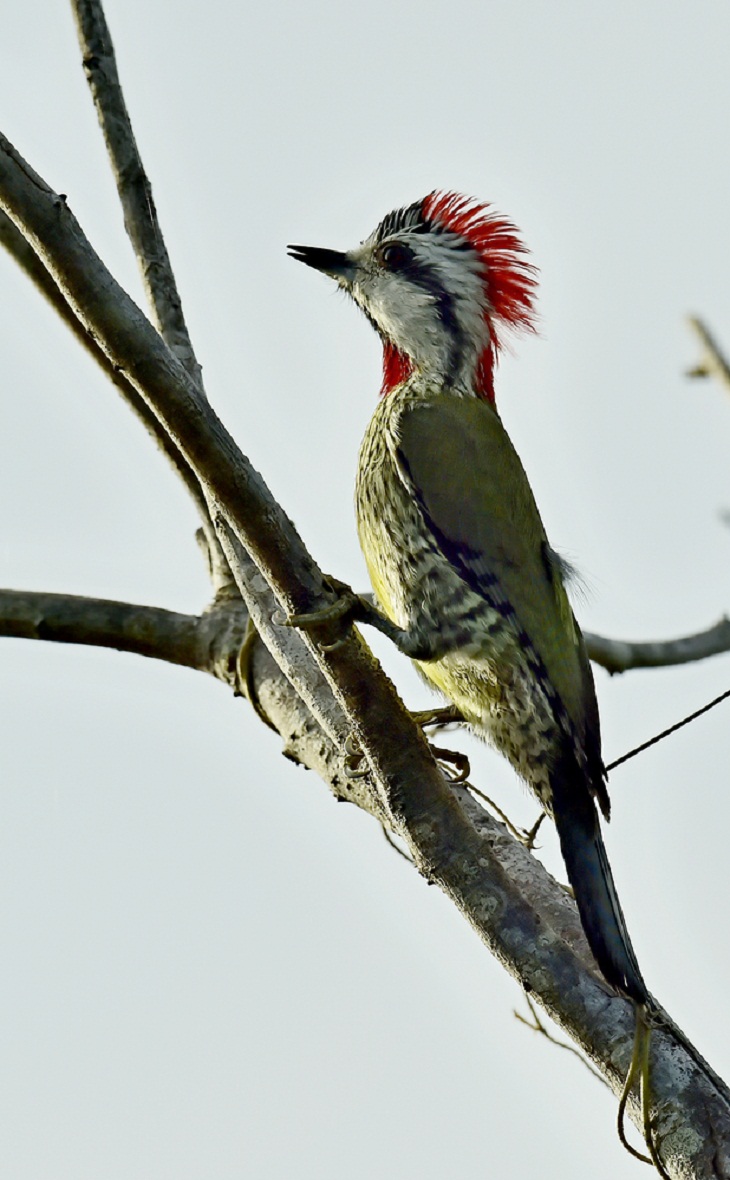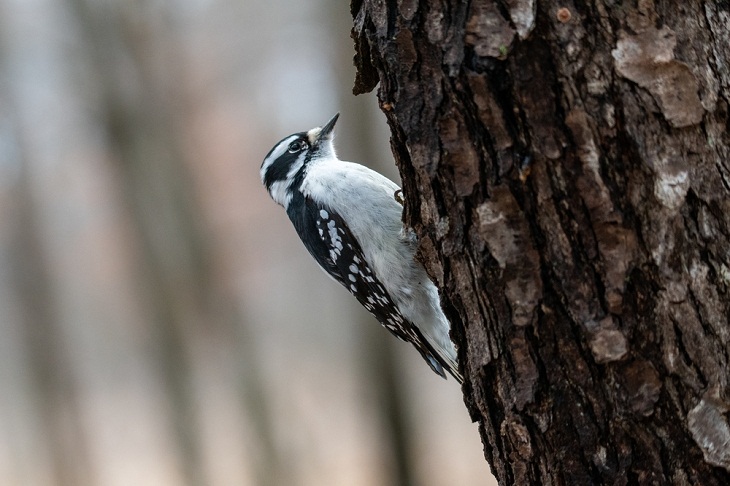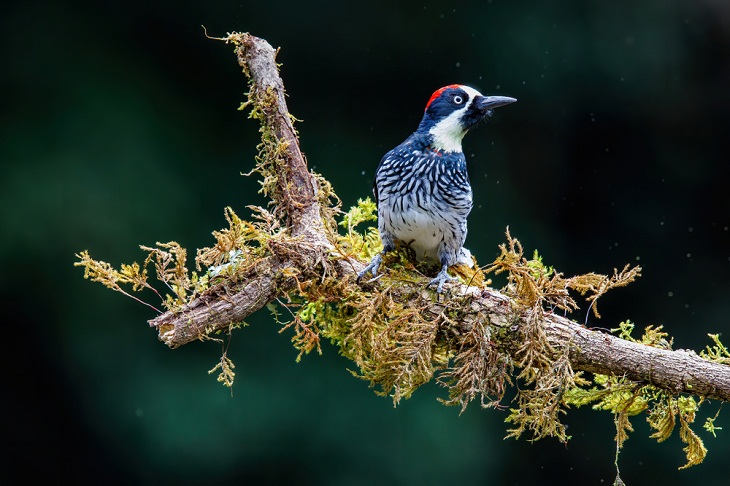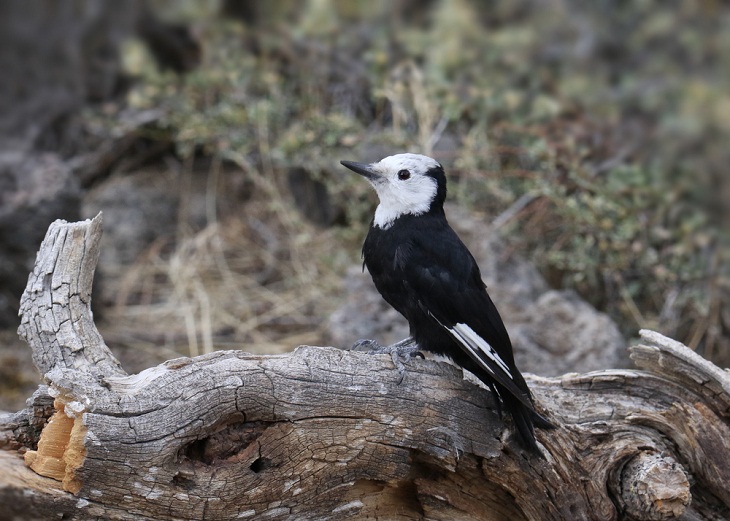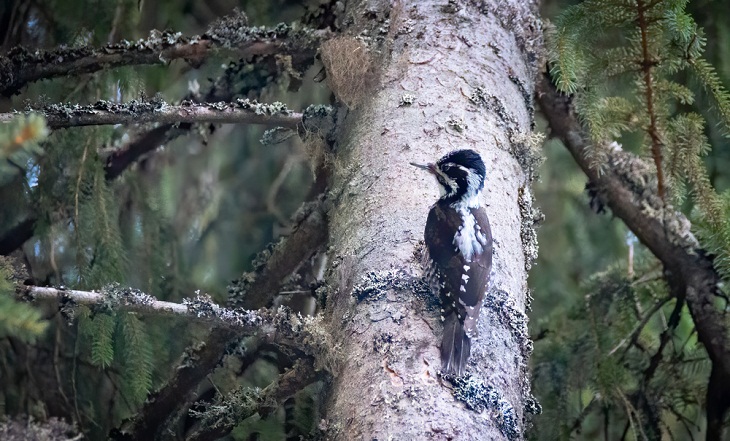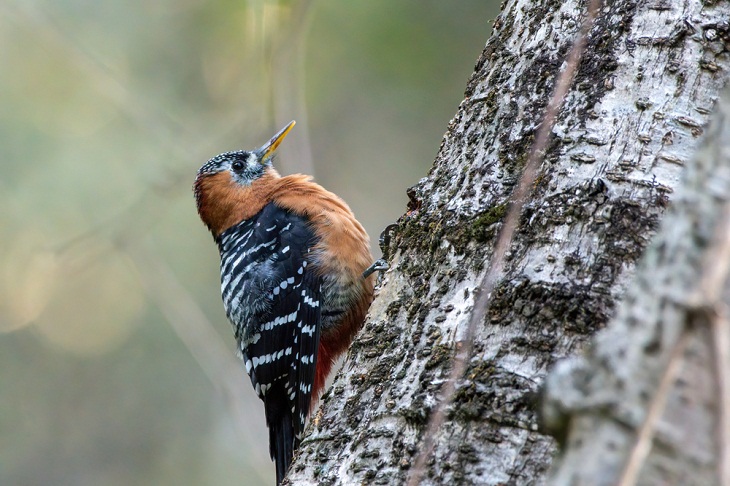The name of this handsome woodpecker is actually misleading. You’d think this bird has a striking red belly. It doesn’t. Instead, the red-bellied woodpecker (Melanerpes carolinus) sports a black-and-white striped back with a bright crimson nape. The rear of its neck and the top of its head has a characteristic crimson tinge.
The red-bellied woodpecker consumes insects, berries, and nuts in addition to being able to grab flying insects in midair. This species is found only in the eastern United States and is most common in the southeastern states.
2. Himalayan Woodpecker
The Himalayan woodpecker (Dendrocopos himalayensis) is found in Afghanistan, Pakistan, India, Bhutan, and Nepal and inhabits the boreal and temperate forests in the Himalayan Ranges and neighboring areas. It is distinguished by its black back with broad white patches running from the shoulder to the lower back. A distinct black stripe runs around the ears to the base of the bill.
The call of these woodpecker species is a single "kit" sound.
3. Great Spotted Woodpecker
The great spotted woodpecker (Dendrocopos major) is a medium-sized woodpecker distinguished by its striking black-and-white plumage and bouncing flight. Most of the time, it is seen clinging to tree trunks and branches, hiding on the side away from observers.
This bird often announces its presence with a spring drumming display. It’s fairly common in England and Wales and is also found across much of Eurasia.
4. Golden-Fronted Woodpecker
Featuring a zebra-patterned body and yellow and red speckles on its head, the golden-fronted woodpecker (Melanerpes aurifrons) is unlike any other woodpecker you will ever see. This robust, medium-sized woodpecker of eastern Mexico and northern Central America has a long, pointed bill and inhabits brushlands and dry woodlands, especially mesquite, oaks, and cottonwoods. When their habitats overlap, golden-fronted and red-bellied woodpeckers have been observed to be at loggerheads and aggressively defend their territories.
5. Red-Naped Sapsucker
Sapsuckers, a specialized group of woodpeckers, attack living wood to get at the sap inside. The red-naped sapsucker (Sphyrapicus nuchalis) has a sweet tooth and regularly feeds on berries, fruits, and saps. It drills neat holes in aspen, birch, and willow trees to drink their sugary sap.
This striking woodpecker is common in the Rocky Mountain and Great Basin regions of America. The bright red patches on their heads and below their sharp beaks will captivate you.
6. Chestnut Woodpecker
Occasionally referred to as the elegant woodpecker, the chestnut woodpecker (Celeus elegans jumana) is completely dark chestnut brown, including its large hammerhead crest. It is usually found in the midstory level of varzea forests (seasonal floodplains that occur in the Amazon Biome), or along the edge of streams and oxbow lakes. It is known to feed on both ants and termites.
This species has a very wide distribution and can be found in Belize, Costa Rica, Guatemala, Honduras, Mexico, Nicaragua, and Panama.
7. Red-Headed Woodpecker
This species is almost impossible to miss due to the rich scarlet hue of their heads, which extends to the upper breast area. They can also be identified by their distinct, sharp chirp. The red-headed woodpecker (Melanerpes erythrocephalus) is adept at catching insects in midair and prefers to store its food in tree crevices.
This woodpecker favors groves, farms, forest edges, and orchards. It appears throughout the central and eastern United States and southern Canada. The red-headed woodpecker was once widespread in eastern North America, but its numbers have dwindled in recent years.
8. Black Woodpecker
This crow-sized woodpecker, almost entirely black except for a red crown, lives in the deciduous woodlands of western North America, south to Colombia. The black woodpecker (Dryocopus martius) is an alert and curious bird that is sometimes very noisy. It makes a screech-like shrill while in flight. Black woodpeckers do not have a dipping, bounding flight like other woodpecker species, but produce slow, irregular wing beats with their heads raised.
9. Cuban Green Woodpecker
The Cuban green woodpecker (Xiphidiopicus percussus) is an incredibly attractive, medium-sized, vibrant bird that resembles a sapsucker in terms of size and general appearance. It is the most widespread woodpecker in Cuba, primarily inhabiting woodlands, as well as dry and wet forests, pine forests, and mangroves. This woodpecker's upper parts are green, while its underparts are yellow with black streaks. The sides of its head are white, with a black stripe behind its eyes.
The Cuban green woodpecker has the ability to remain completely still for long periods. It usually forages for dead insects and is found most frequently in pairs.
10. Hairy Woodpecker
The hairy woodpecker (Dryobates villosus) is distinguished by the red dot on the back of its head and its black and white feathers. It inhabits dead woodland trees, where it feeds on insects and sporadically releases sap. The hairy woodpecker can often be mistaken for the downy woodpecker (Dryobates pubescens) because of how similar they look. The bill and size of the hairy woodpecker, however, are much larger than those of the downy woodpecker.
This charming bird has a straight-backed posture and can be observed nesting either at sea level or high in the mountains. It is also known to follow other woodpeckers to check for leftover food in the trees from which they have pecked.
11. Acorn Woodpecker
This wacky woodpecker loves to bury acorns in the small holes it makes in dead trees. This is especially helpful for them when they struggle to find nuts during the winter. Interestingly, the acorn woodpecker (Melanerpes formicivorus), in contrast to the majority of other woodpeckers, seldom feeds on wood-boring insects.
It dwells in oak and pine-oak woodlands throughout western Oregon, California, and the Southwest, as well as in Mexico and Central America. These birds nest in groups of up to a dozen or more and rarely leave their territories.
12. Pileated Woodpecker
The pileated woodpecker (Dryocopus pileatus) is one of the largest in America, boasting a size of nearly 20 inches and a wingspan close to 30 inches. Birdwatchers are drawn to the bird's striking bright red crest and pair of black-and-white wings. It resides in open pine forests with large, widely spaced older trees in North America. The bird establishes its territory by drumming loudly on trees with its bill.
The pileated woodpecker came close to extinction a while back because of rapid deforestation. Thankfully, its numbers have been on the rise since the 20th century.
13. White-Headed Woodpecker
The mountainous pine forests of the western states and British Columbia are home to glossy white-headed woodpeckers (Dryobates albolarvatus). They have gleaming white heads and necks with small red spots on the crowns of their heads.
Rather than drilling into wood or trees, these woodpeckers scrape away the bark with their beaks. White-headed woodpeckers love to feed on pine seeds and are known to be unusually silent.
14. Eurasian Three-Toed Woodpecker
The Eurasian three-toed woodpecker (Picoides tridactylus) is a non-migratory bird that lives primarily in the Palearctic zone, including parts of Scandinavia, Latvia, and parts of Moscow, Siberia, and Mongolia. This woodpecker is nearly identical to the American three-toed woodpecker (Picoides dorsalis), and distinguishing between the two may be difficult.
In recent years, the number of Eurasian three-toed woodpeckers has declined due to the destruction of old coniferous forests and the fragmentation of mountain ranges. It is in these areas that they find food and habitat, particularly in Pirin National Park in southwest Bulgaria.
15. Rufous-Bellied Woodpecker
This sap-sucking woodpecker has a vast range that extends from the Himalayas to Southeast Asia, Vietnam, eastern China, and even Korea. The sap holes they create are an invaluable source of food for a variety of forest animals and birds.
Rufous-bellied woodpeckers (Dendrocopos hyperythrus) have white-barred black mantles and wings while their throat and belly are rusty brown or cinnamon. They are quite picky about their habitat and prefer undisturbed oak forests. Apart from plant saps, they also feed on various insects.
Frequently Asked Questions
What is the world's smallest woodpecker?
In terms of size, the tiniest species of woodpecker in the world is the Bar-breasted piculet (Picumnus aurifrons), which measures less than 7.5 cm in length and weighs approximately 8–10 grams.
What is the rarest woodpecker?
The ivory-billed woodpecker (Campephilus principalis) has been thought to have been extinct for more than 40 years. The species has been largely destroyed by unrestrained logging and was also wiped out by bird hunters because of its large size. During the IUCN's most recent assessment in 2020, it was estimated that only one to 49 individuals of this precious bird remain.
How strong is a woodpecker's beak?
Woodpeckers, as you may know, use their beaks to hammer into trees in search of insects, which they extract with their long tongues. Their beaks can strike wood at a speed of 25 mph (40 km/h). The head of a woodpecker strikes with at least 1,000 times the force of gravity (1,001 g), yet the bird remains unharmed.
Share this post with friends and family!

